
 |
WAITING
FOR THE SHADOW
SOLAR AND LUNAR ECLIPSE OBSERVING |
|
|
|
|
|
|
|
|
|
Total Lunar Eclipse October 8th, 2014
The
Night of the Blood Moon
In the lead up to this eclipse, the media coined the term "blood moon." With their limited understanding of all things scientific, the media always need to over-reach and then over-use some silly buzz word to add interest to their story. One example is the "supermoon" phenomena Every year, one full Moon coincides with the time each month when the Moon is at closest approach, they use the term "super moon"because they can't spell perigee. This was the case with the term "Blood Moon." The term comes from a book by two clerics which details a fanciful and ridiculaous construct connecting the occurrence of four lunar eclipses in a row, with the coming of the anti-christ.
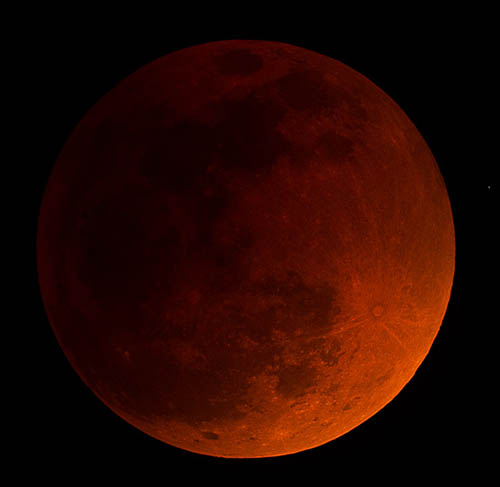 2007 total lunar eclipse |
Blood Moons in Biblical prophecy Reference : http://earthsky.org/space/what-is-a-blood-moon-lunar-eclipses-2014-2015#prophecy Two Christian pastors, Mark Blitz and John Hagee, have coined the term Blood Moon in their 2013 book, "Four Blood Moons: Something is About to Change" to apply to the full moons of the ongoing tetrad. A tetrad is the occurrence of four successive total lunar eclipses, with no partial lunar eclipses in between, each of which is separated from the other by six lunar months (six full moons). Indeed such a series of events occurs in 2014 and 2015. Their thesis is based on this piece of biblical prophecy : - Joel 2:31 (Common English Bible): The sun will be turned to darkness, and the moon to blood before the great and dreadful day of the LORD comes. That's all very well. The problem is that there have been 62 tetrads in the last 2000 years and 6 more this century. Blitz and Hagee place extra significance on this tetrad because it coincides with Jewish Passover and Tabernacles. However 8 of the 62 tetrads in the last two millennia coincided with these Jewish feasts. I wrote a reference on this web site in my preview to the November 2012 total eclipse about the eclipse "crossing the Australian Coastline over a 130km wide track between Cape Tribulation and Innisfail." This statement was latched onto by biblical prophecists as a sign that that total eclipse marked the beginning of the "Great Tribulation." [The coming of the antichrist] Miraculously, we are still here and fire and brimstone have not rained down upon us and we'll still be here minus the second coming after this run of lunar eclipses finishes - have a little faith! |
This
was my first decent
view of a lunar eclipse since August 2007. The few
opportunities
I've had since 2007 have mostly been clouded out.
Cloud was
predicted to interfere with
observations along large tracks of the eastern seaboard of Australia.
This low (<2000m) cloud only penetrated inland to the
great
dividing range. Canberra, situated between two arms of the
divide
was
predicted to be cloudy in the east and clear in the north west.
At
sunset, the cloud appeared exactly as predicted by weather models - cloudy in the city
centre and the east. We drove up the Barton highway out from
under the cloud to the north
west border of the Australian Capital Territory.
This drove out from under
the cloud to the Hall Showground and set up during the partial
eclipse.
Observing Location Eclipse observed from Hall Village north west part of Canberra, Australia. Observing Conditions .......LATITUDE : ......-35o 10' 13.2"..........LONGITUDE : ......149o 04' 24.0" Sky conditions clear - no cloud or mist in the sky near the moon. Some cloud low on the east horizon. Transparency 7/10 Seeing 5/10 Moon altitude at Beginning of totality 25o mid-totality - 30.5o End totality 35o Limiting magnitude approx 5.0 Visual Observations ......Danjon estimate : 3 ......I've seen brighter totalities but I've seen MUCH MUCH darker ones. Appearance : relatively bright and brick red near outer umbra to very dark rust on dark limb. Other observations : - Earlier this year, a total eclipse occurred during twilight as observed from the eastern states. In my preview article for that eclipse, I predicted that such a twilight lunar eclipse would not begin to become visible until between the time of civil twilight and nautical twilight bepending upon the eclipse brightness. Unfortunately that eclipse was clouded out so I couldn't confirm by observation. This eclipse, Perth experienced the twilight eclipse. Perth observer Stephen Le Page and I corresponded prior to this eclipse. I supplied the same sort of prediction to him for observers in Perth. I wrote to Stephen : - Your time line should also reference civil, nautical and astronomical twilight. PERTH Lat=-31°57'00" Long=+115°51'00" MOONRISE 18:18 SUNSET 18:23 TOTALITY BEGINS 18:25 CIVIL TWILIGHT 18:48 TOTALITY ENDS 19:24 NAUTICAL TWILIGHT 19:17 ASTRONOMICAL TWILIGHT 19:46 PARTIAL ECLIPSE ENDS 20:34 A total eclipse needs 2-30s expoure at f4 ISO 100. These sort of exposure times in landscape photography are usually found at "first light" between astro and nautical twilight. I'd be surprised if you could see it at the beginning of totality with the atmospheric extinction near the horizon + dim totality working against you. You might see the end of the partial eclipse just before totality begins but I'm dubious. At a guess, I'd estimate the total eclipse will become visible between civil & nautical twilight towards but before the end of totality - somewhere between 1845 and 1915 depending on the danjon value of the eclipse. The moon won't be low on the horizon. Could you note the actual time it become visible through twilight and let me know. It will help me when writing future articles. Stephen Le Page wrote back to me after the eclipse : "I ended up shooting these from Swanbourne, 8.3 km away from the city, to try to make the moon appear relatively large behind the city. It was really interesting to me knowing precisely where the moon was, but still not being able to see it until 18:45 when it was 4.5 degrees above the horizon (way above the city skyline) because it was so dark and was completely washed out by twilight. Your estimate was spot on." This is a great observation to have in my pocket for future eclipses. A very dark lunar eclipse could quite possibly remain invisible until nautical or even astronomical twilight. But Stephen's observation gives me a little bit of hard data upon which to base future predictions. Joe Cali |
All the enlargements below were taken with the same setup :

Image above : - ED 80mm f7.5 refractor. Average of 4 exposures 1/4s ISO 800. Exposures taken between 11:08:55 -11:09:06 UT.

This is a frame grab from a time-lapse video I made that can be viewed in the window below.
Lunar eclipse October 2014 5X from Joe Cali on Vimeo.
 10:19:07UT |
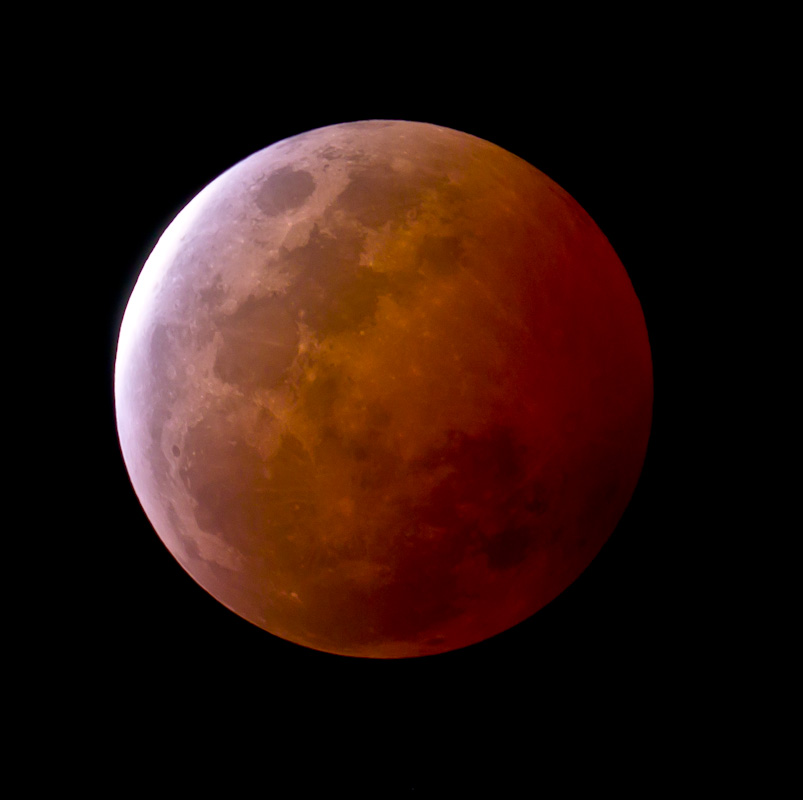 10:21:50 UT |
 10:24:54 UT |
 10:33:46 UT |
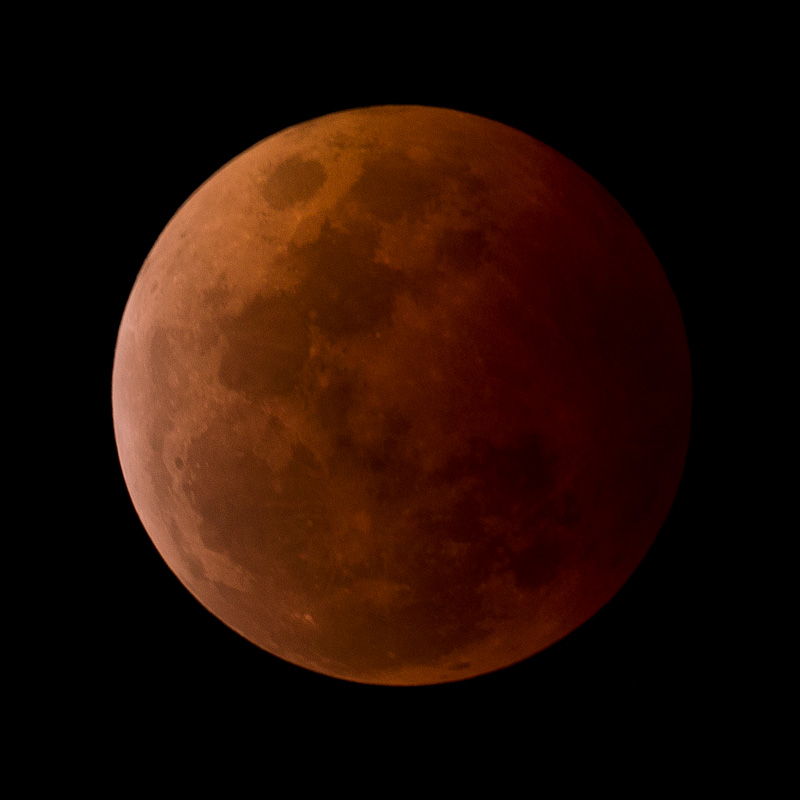 10:44:12 UT |
 11:03:01 UT |
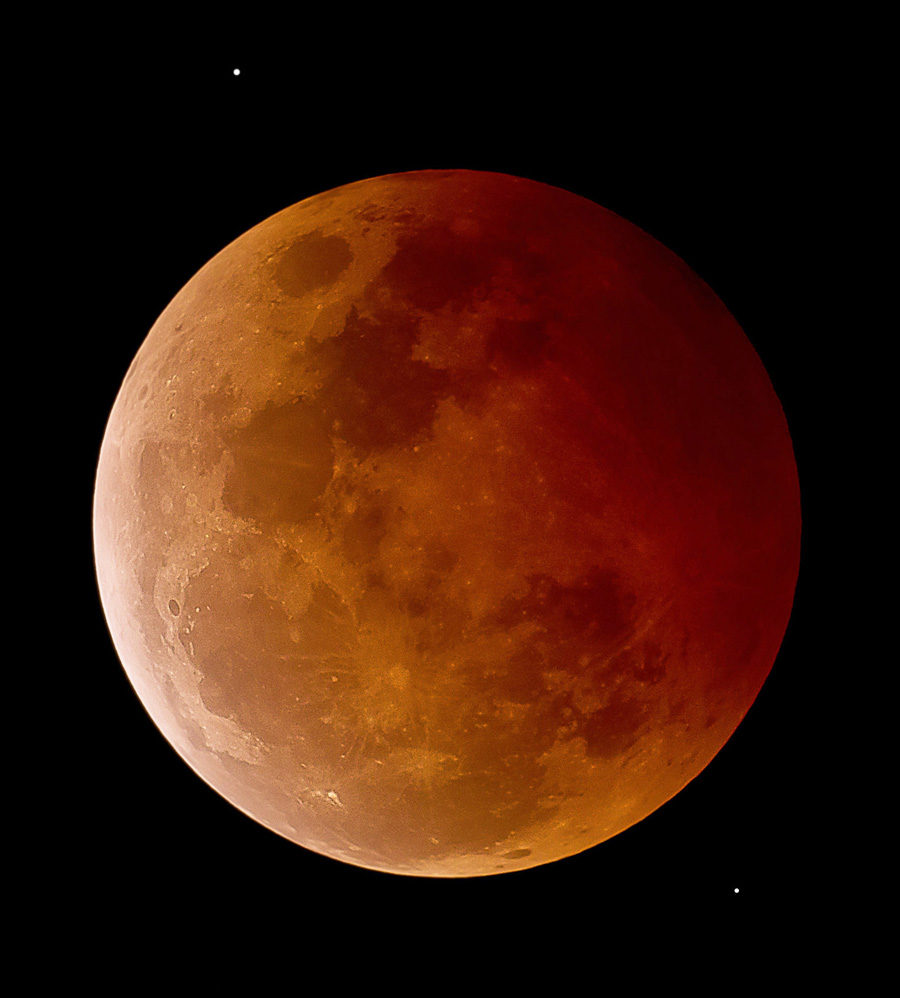 11:03:01UT reprocessed
Average of 3 x 1s subs taken between 11:02:42 - 11:03:16 |
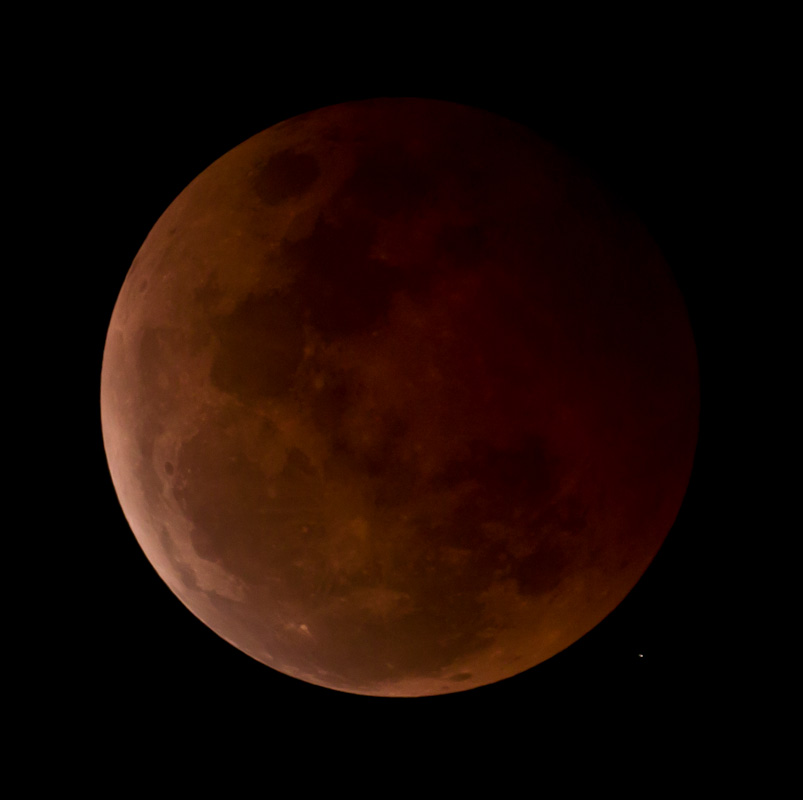 11:08:58 UT |
 11:36:17 UT |
 11:43:56 UT |
A proposed possible new method
for estimating or recording eclipse brightness?
The traditional method for
estimating the brightness of a lunar eclipse is to make an estimate on
the Danjon scale. This is a subjective visual scale
developed in 1922 to record the brightness of a lunar eclipse.
L = 0 Very dark eclipse. Moon almost invisible, especially at mid-totality. L = 1 Dark Eclipse, gray or brownish in coloration. Details distinguishable only with difficulty. L = 2 Deep red or rust-colored eclipse. Very dark central shadow, while outer edge of umbra is relatively bright. L = 3 Brick-red eclipse. Umbral shadow usually has a bright or yellow rim. L = 4 Very bright copper-red or orange eclipse. Umbral shadow has a bluish, very bright rim. reference : http://eclipse.gsfc.nasa.gov/OH/Danjon.html USA based observer Mark Egan made a very valid point on the solar eclipse mailing list that having experienced a range of brighter and darker eclipses for comparison will help in making an accurate Danjon estimate. Australian occultation observer, Dave Herald also makes a valid point about never having two eclipses in the sky at the same time to compare. Danjon estimates are highly subjective. June 1993 ; I observed that the Moon had barely any colour, perhaps a deep dark charcoal brown and was difficult to see. I have made an illustration here to depict the visual appearance http://www.joe-cali.com/eclipses/PAST/TLE19930604/TLE1993.html On this occasion the Moon could only be seen in the sky with partly dark adapted vision. I went into the lit house during totality and when I emerged, I could not see the moon for about 30-60s. Neighbours came over and asked what was there to look at. I told them it was a lunar eclipse. They asked when the moon would rise. I had to point out the moon to them before they could see it. These observations were much closer to the city (3km) but the milky way was clearly visible. I agree with comments made about the subjective nature of the Danjon scale and also about difficulty trying to measure colour with a DSLR on processed images. Not every observer will own a DSLR but I would imagine large numbers do own one. DSLR's are standardized wrt ISO. DSLR's can be quite easily profiled to give comparable colour metrics. These measurements should naturaly be performed on unprocessed raw images with defined parameters. Limb brightnesses Method 1 Set the camera to ISO 100 f8 and daylight white balance. At mid totality do a full spread of shutter speeds at 1/2 stop intervals. Then analyze the images later and note the two shutter speeds at which the bright and dark limbs of the moon merge into the background noise. This would give a reasonable & comparable estimate of the brightness of the two limbs. It will vary with the observers sky transparency, light pollution etc. One of the longer exposures could be used to examine stars in the sky and obtain a limiting magnitude. Physical aperture (lens diameter) would need to be standardized or at least noted. Something like a 50mm fixed FL standard lens might provide some measure of comparability although a longer FL 200-600mm would be easier to analyze. Different cameras have different noise levels. Method 2 Set the camera to ISO 100 f8 and daylight white balance. At mid totality do a standard shutter speed of say 1/8s (exact Tv would need to be worked out). Measure pixel brightness values on dark and light limb. Colour If the camera owner wants to profile their DSLR, a simple process with an IT8 target and the appropriate software, colour measurements could also be made that might not be spectroscopic quality but better than a visual estimate of colour. |